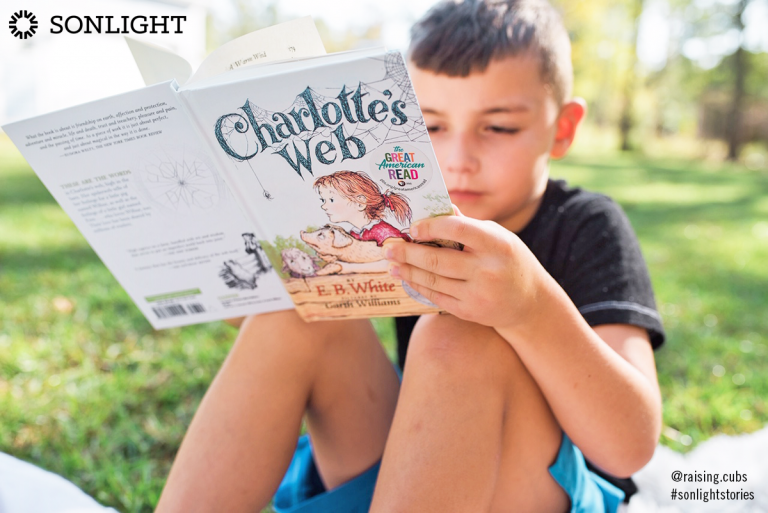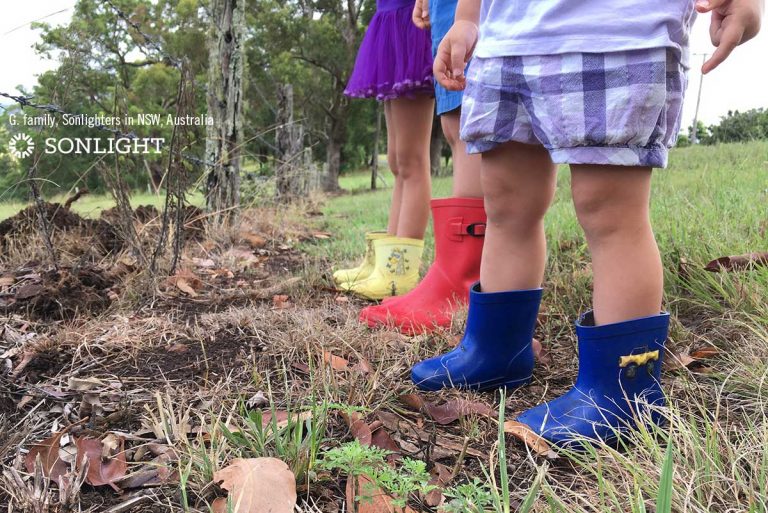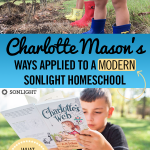
Charlotte Mason was a school teacher in England during the late 1800s. Her dissatisfaction with the education practices of her day impelled her to devise a new method of teaching that would provide a broad curriculum to all her students, regardless of social class. In her day students from the lower economic class learned trades while students from the upper economic classes learned arts, literature, and other deeper subjects.
Through her training school and her books, she instructed parents how to become effective teachers of their children—homeschoolers, although that term wasn't used of course.
Charlotte Mason’s 3-Part Model of Education
Mason based much of her teaching on a model she created to describe what education should be: an atmosphere, a discipline, a life.
1. An Atmosphere
Mason believed that education at home begins with an educational atmosphere. Children should be surrounded by things that make them want to learn.
For example, she was an advocate of having children spend much time outside in nature, learning directly from nature itself. And she also believed in giving children high quality books. In addition, she knew that the attitudes of parents and tutors have a huge impact on how much children love learning.
How Sonlight Provides an Atmosphere
Sonlight curriculum provides a great atmosphere for learning by delivering a huge box of engaging books straight to your doorstep. The science programs bring nature indoors via the books and suggested activities. In addition, shorter lesson plans mean that children have more free time to spend outside enjoying and learning from nature. The lesson plans do much of the planning for you, so you also have time to get out and explore with your children. Finally, enjoying great books alongside your children with the Read-Alouds provides a home atmosphere of learning.
2. A Discipline
Part of Mason’s approach involved creating a discipline for your children. Usually when we think of discipline or habits, we think of chores and routines. Brushing teeth, making the bed in the morning, and getting ready for the day are all great areas of discipline to work on.
Another area of discipline most parents focus on is character training. Teaching children to obey and listen is sometimes a full-time job unto itself. But Mason took this approach one step further. She believed that discipline should be a series of habits. She taught parents to encourage in their children:
- logical thinking
- deductive reasoning skills
- self-restraint
- delayed gratification
How Sonlight Provides Discipline
Sonlight creates a spirit of discipline in your home by giving you organized guides that lay out a daily routine of work, step-by-step. Moral values and character training are built right into each day's lesson. Children learn from a young age to apply logic and deduction skills as they read stories with opposing viewpoints and then discuss those ideas with their parents.
3. A Life
Mason didn’t simply mean that education should be a lifestyle although she did believe that. But she also believed that education should be learning about life.
- the lives of heroes who acted with bravery and self-sacrifice
- the works of musicians and artists who gave the world beauty
- the impact of inventors, politicians, and activists and what motivated them
But even more than that, she advocated for living books—books that brought the author’s passion for the subject to the forefront and made history come alive.
How Sonlight Provides Life
Sonlight offers a spirit of life in your homeschool by filling your house with living books on a great many inspirational people, places, and events. Some books are historical fiction, which help your child feel as if they are living in an accurately recreated time period. Other books bring real people to life by having your child view life through their eyes.
Sonlight also includes great electives such as classical music that helps bring composers to life, and over-sized picture books that help children see art up close. Missionary stories display the power of God, enabling your kids to feel both the hardships and the triumphs of the mission field.

Defining Characteristics of a Charlotte Mason Homeschool
Living books, habit building, art study, music study, and time in nature are large components of a Charlotte Mason homeschool, but here are a few more:
- Short Lessons Sonlight breaks up large books into small amounts of daily reading, growing in length as your child grows in years. You’ll find in the lower levels, for which much of CM’s methods are written, each individual lesson is only a few minutes long. You can do a couple of short lessons together or take a quick break between them.
- Narration Sonlight incorporates discussion questions with answers rather than a strict narration format. These discussion questions help students evaluate the book more deeply. As parents grow in confidence, they find a few key narration questions work for most any reading passage: "What did you learn from this story?” and "What would you do?"
- Copywork and Dictation Sonlight Language Arts incorporates copywork and dictation at least once a week in the 4-day program and twice a week in the 5-day program, once the child is reading and writing. Younger students will practice copywork, and the ability to switch over to dictation is available when your child is ready.
- Nature Studies While Sonlight can’t bring the great outdoors to your house, they do include numerous books which bring nature to your home. Books with full-color, close up photographs of nature and animals are available in the lower levels, and books in the natural sciences are included in higher levels.
- Free Afternoons Many parents of younger children find they are often done by noon (providing they don’t start late in the day as we do), so they have their afternoons free to explore their world, whether from the inside of a museum, a grocery store, or the great outdoors.
If Charlotte Mason Lived Today...
Some think that if you brought Miss Mason into the modern world, her whole philosophy would no longer work. I don’t believe that.
I think if Miss Mason could magically be teleported into our time, she would strongly support using the vast new resources that are available in our modern day. She would in no way want us to adhere strictly only to the books and methods she used in her time. She would find high quality books among modern authors. She might even have favorite Twitter accounts and Facebook pages!
Charlotte Mason used what she had. Let's see what she had compared to what we have today.
Charlotte Mason Used Nature
All around her were untouched wild lands, fields ripe with life, and places to freely explore whenever she and her students had a desire.
Today with increasing urbanization, many wild areas are cordoned off, with special paths for walking and signs telling children not to touch the plants or play in the ponds. While there are still many farm families who have unlimited access to nature in their area, many urban and suburban children are limited in their experiences with nature. Modern day nature study needs to look different for the modern Sonlight homeschool family. And Charlotte Mason would absolutely approve of zoo trips counting as nature study!
Charlotte Mason Used Books
Charlotte Mason loved books, but the only books that made it on her approved list were ones published before and during her lifetime. She had books that were written mainly to adults and had very few pictures. (Children's literature wasn't really a thing in the late 1800s.) When she wanted a new book for her students, she had to travel by horse, look through the slim pickings, or rely on suggestions by friends and other educators.
She didn’t have curriculum shops with free shipping, loyalty programs, and a guarantee. In fact, she had to wait months for books to arrive with no sneak peek inside and no customer reviews to determine appropriateness for children. Her books came with black and white illustrations, rather than full-color, glossy photos. She did the best with what she had and constantly sourced new materials, but her books were much more limited than what we have available today.
Would Charlotte Mason forbid families use modern day books? Of course not! We can look at what she chose from what was available and made inferences about what modern books would also qualify as CM-worthy.
Charlotte Mason Used Paper and Slates
Children recorded what they saw and learned on paper and on slates. Those were the tools she had. Charlotte Mason didn’t have Netflix or Prime Video that brought far away ecosystems and historic locales right into the living room. She didn’t have internet search or Google maps for children who wanted to know more. She didn’t have access to information at her fingertips.
I think Miss Mason would have embraced nearly every form of modern learning that puts children in the presence of worthy ideas.
- a natural museum full of mummies, dinosaur bones, and historical artifacts
- a zoo webcam showing the birth of new baby giraffe
- e-readers with the ability to store hundreds of books in an conveniently portable format
Can you imagine how she would have rejoiced with the wealth of great books of today? And how easily it is to access them either with inter-library loan or shopping online?!
Charlotte Mason would be absolutely giddy with all the information she could access online today for learning. She would still make everything pass the test of living (book/website/resource) vs. twaddle. If she were alive today, her curriculum would look very different from what she espoused in the late 1800s. In fact, I think a modern day CM curriculum would look an awful lot like Sonlight.









I have just purchased Sonlight curriculum to begin homeschooling my 8th grade student. He may be heading for knee surgery and will benefit from some academic flexibility. We look forward to seeing what Sonlight has to offer our lives. I am very encouraged by the testimonials I have read from parents who have used this curriculum in the past.